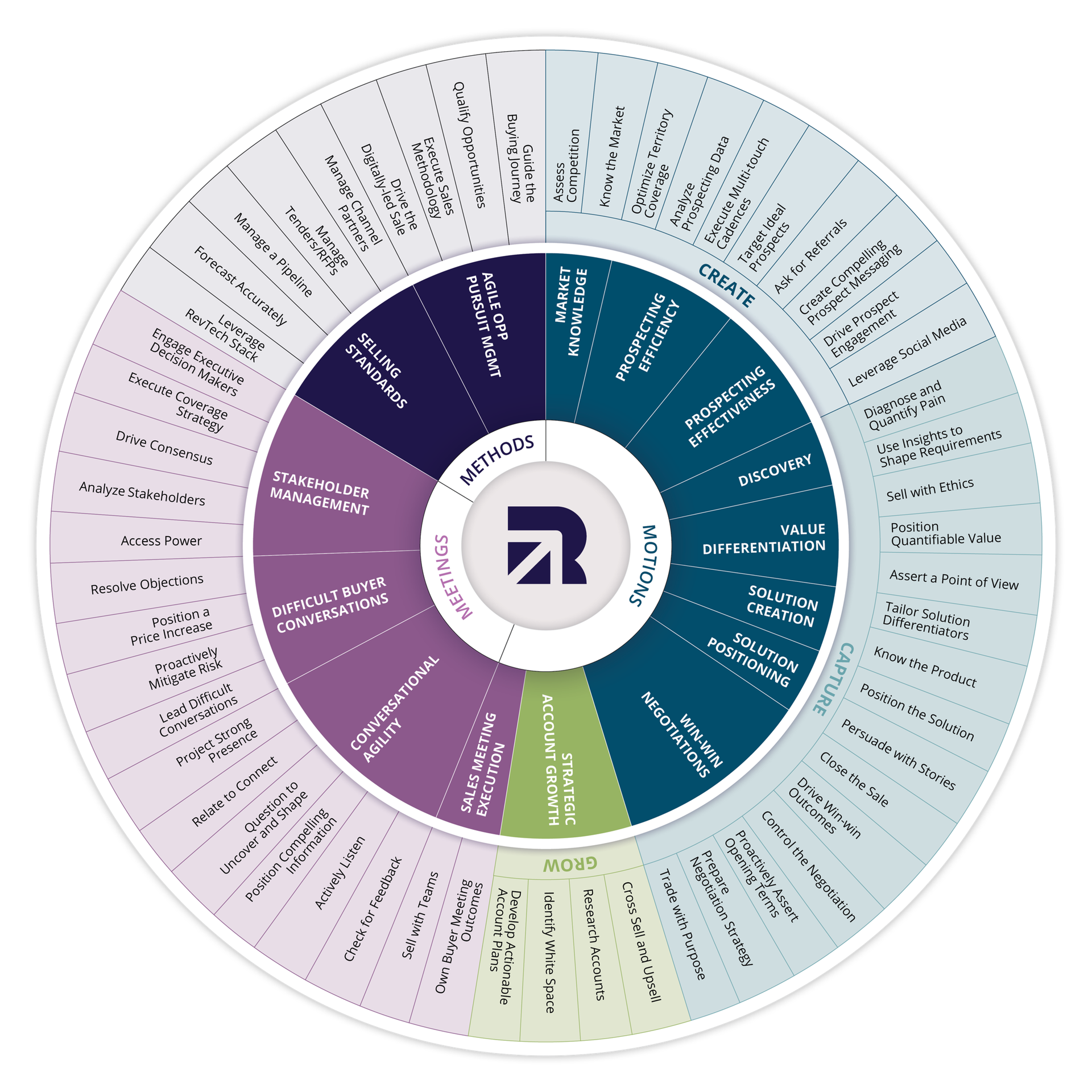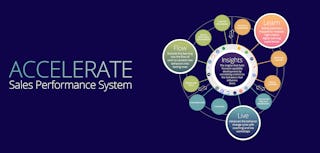
Sales Capability Framework
Develop diverse selling capabilities to help your team stay agile and adaptable.
How the Right Sales Capabilities Set Your Team Apart
In today's selling environment, sales professionals need a wider range of capabilities. Developing diverse selling capabilities helps sales professionals stay agile and adaptable amidst market changes and increasing customer demands.
However, there is no single competency that drives sales excellence — rather, it is a collection of behaviors and skills across the selling process that need to be understood and practiced.
What are Sales Capabilities?
Sales capabilities are the combined skills, strategies, knowledge, and resources that sellers use to succeed in their roles. These capabilities are essential for achieving sales targets, building customer relationships, and driving revenue.
Sales capabilities can be improved through training, experience, and ongoing professional development. To stay competitive in their markets, successful sales organizations develop a sales capability framework to identify what excellence looks like for various sales roles — and which sales capabilities should be developed to drive the most impact.
Richardson's Sales Capability Framework
Richardson’s Sales Capability Framework is a complete collection of 15 sales capabilities supported by 55 sales behaviors that sellers must master to enhance their commercial selling competitiveness. They build competencies that enable your sellers to perform effectively in their roles to achieve strategic business goals. The Sales Capability Framework is brought to life through our NEW Accelerate Sales Performance System, a comprehensive sales capability-building solution that brings clarity to the most critical skill gaps you need to address to move your business metrics.
Each capability is underpinned by specific selling behaviors that map to modular, high-impact digital learning assets. Personal learning recommendations are delivered based on real-time performance metrics and capability assessments. Sellers experience both digital and live training experiences and can access content across multiple formats including video-based modules, knowledge checks, assessments, and real-world practice scenarios to deliver optimum outcomes.
Richardson’s Sales Capability Framework is rooted in best practices from Richardson’s deep, broad, and proven curriculum that has been curated over 45 years, is science-backed, and isolates the skills needed to improve results and reduce the duration of the sales cycle. It ensures sellers are successful in the following key areas:
- Sales Methods - the capabilities sellers must employ to execute your sales standards, guidelines, and methodology
- Sales Motions - the capabilities sellers must employ to execute the sales process in creating, capturing, and growing business
- Sales Meetings - the capabilities sellers must employ to effectively engage their buyers

Sales Methods
These capabilities enable sellers to effectively achieve your organization's sales standards and execute an agile sales methodology.
Capabilities to Achieve Selling Standards
Building skills to ensure your team is achieving selling standards requires training to develop the following behaviors:
- Manage Channel Partners: Developing and managing relationships with channel partners to drive revenue by regularly updating partners on vision, products, support, and other relevant information, establishing and monitoring key performance indicators (KPIs) for partners, facilitating necessary resources, training, and support to empower partners, and planning and executing activities with partners for key accounts/opportunities.
- Manage Tenders/RFPs: Participating in a formal or regulated bidding process for opportunities by managing timelines, responsibilities, and deliverables effectively, maintaining a client-centric focus in the response, addressing the specific needs and goals of the prospective client, and highlighting unique selling points that differentiate responses in the proposal from competitors.
- Manage a Pipeline: Organizing, monitoring, and optimizing the flow of opportunities through the stages of the sales process by managing volume, speed, and distribution of opportunities at each stage of the pipeline to meet pipeline goals.
- Forecast Accurately: Creating accurate sales forecasts by complying with the organization's established forecasting methodology.
- Leverage RevTech Stack: Using the organization's sales tools and platforms to advance opportunities and report progress by developing proficiency using core sales tools and platforms to maintain accurate and up-to-date data as required.
Capabilities to Execute an Agile Sales Methodology
Building skills to ensure your team is executing an agile sales methodology requires training to develop the following behaviors:
- Guide the Buying Journey: Helping the customer gather the necessary information to make an informed buying decision by understanding the customer's buying journey, aligning sales strategy, activities, and approach to each stage, and co-creating a plan with the customer to guide them through the stages of their buying journey.
- Qualifying Opportunities: Determining if the customer is a good fit for the proposed product or service by following established qualification criteria for assessing opportunities.
- Executing the Sales Methodology: Following a consistent, repeatable process to identify and win sales opportunities by executing best practices and using sales tools recommended by the methodology consistently throughout the sales process.
- Drive the Digitally-led Sale: Blending human and technology actions to understand and enrich the customer's digital research with fresh insights that add value throughout the buying journey by analyzing and anticipating the customer's digital interactions to identify where, when, and how to add value, and bringing fresh insights to the customer in ways that amplify their buying experience.
Sales Motions
These capabilities enable sellers to execute the sales process in creating, capturing, and growing business.
Capabilities to Create Business
Building skills to ensure your team can earn opportunities for new business requires market knowledge, prospecting efficiency, and prospecting effectiveness which requires training to develop the following behaviors:
- Assess Competition: Evaluating competitors’ products, services, and sales tactics, to determine their relative strengths and weaknesses by monitoring competitor relationships and activities within accounts then adapting strategies accordingly, and selecting the appropriate competitive strategy to execute related tactics in competitive opportunities.
- Know the Market: Staying abreast of market dynamics, key industry drivers, and market competitors by being able to demonstrate a deep understanding of your buyer's business.
- Optimize Territory Coverage: Dividing a target market into defined areas to optimize customer coverage and enhance revenue opportunities by developing a strategic plan for the assigned territory, aligning with overall sales and organizational goals, and including clear objectives and key performance indicators (KPIs) for territory success.
- Analyze Prospecting Data: Using data to analyze the effectiveness of prospecting activities by being capable of accessing data available from prospecting applications and using it to adjust prospecting activities.
- Execute Multi-Touch Cadences: Developing and executing a prospecting cadence by planning and executing a prospecting approach with multiple touches and messages.
- Target Ideal Prospects: Identifying potential customers who fit certain criteria by understanding the characteristics and needs of the target market and ideal customer profile.
- Ask for Referrals: Leveraging success to find leads by asking a satisfied customer for a referral to an individual or organization that aligns with the ideal customer profile.
- Create Compelling Prospect Messaging: Creating value or pain-themed messages that resonate with targeted prospects by tailoring messaging to resonate with the specific needs and pains of the buyer.
- Drive Prospect Engagement: Connecting with prospects to find leads by gaining interest to earn follow-up sales appointments.
- Leverage Social Media: Using social media platforms to connect with potential clients, share insights, and build a professional online presence by building a personal brand through sharing insights and industry knowledge across relevant social media platforms.
Capabilities to Capture Business
Building skills to ensure your team can win new business requires the ability to discover buyer's needs, demonstrate value differentiation, effectively execute solution creation and solution positioning, and engage in win-win negotiations conversations which requires training to develop the following behaviors:
- Quantity and Diagnose Pain: Understanding the customer’s needs and requirements by preparing and asking insightful questions to uncover various aspects of needs, surfacing and quantifying the customer's pain, and exploring ideas for improvement with the customer.
- Use Insights to Shape Requirements: Using insights and questions to influence the customer's perception of their needs by using industry and product knowledge to offer relevant insights and differentiated solutions to address the pain and causes.
- Sell with Ethics: Creating a practice of ethical selling and fostering trust with customers by upholding personal and company ethical standards and avoiding deceptive or misleading practices.
- Position with Quantifiable Value: Incorporating value into every step of the customer buying journey by using metrics and key performance indicators (KPIs) during diagnosis and solution phases to quantify and measure the potential value of the solution, understanding individual customer's metric-based success criteria, and using stories to stimulate interest.
- Assert a Point of View: Sharing a clear and compelling point of view in a way that creates openness and reframes the customer's thinking by displaying confidence in expressing ideas and opinions to guide or reframe the customer's view.
- Tailor Solution Differentiators: Tailoring products or services to meet the unique needs of each customer by designing solutions that reflect their deep understanding of the customer's goals, needs, and pains, and identifying and incorporating differentiators tailored for the customer.
- Know the Product: Maintaining a deep understanding of the products and services offered to customers by possessing a deep understanding of the features, specifications, and value proposition of the product and articulating this understanding clearly and appropriately for diverse audiences.
- Position the Solution: Describing or demonstrating how the product or service brings value and meets customer needs by articulating key features, benefits, and value propositions linked to needs in a structured flow that aids customer understanding and retention, and adapting content and delivery approach to the specific needs and interests of the audience.
- Persuade with Stories: Using stories to convey memorable sales messages by structuring compelling sales stories that lead the audience from situation to resolution, illustrating the benefits and value proposition of the solution.
- Close the Sale: Completing the sale and ensuring customer satisfaction by gaining formal commitment to move forward with a purchase.
- Drive Win-win Outcomes: Reaching mutually beneficial agreements with customers on terms for a product or service by finding agreement on terms within the parameters of their negotiation strategy.
- Control the Negotiation: Understanding the customers' negotiating needs and helping them see the value in your proposal by asking questions during negotiations to understand the customers' underlying interests and reinforce value with insights on potential gains of moving forward, or potential risks of not doing so.
- Proactively Assert Opening Terms: Starting out by offering terms and reacting to the customer's response by opening the negotiation with a clear statement of how the proposed product or service will meet the agreed needs and deliver value.
- Prepare Negotiation Strategy: Preparing strategy and tactics for negotiating terms with a customer or prospect by including bottom-line terms, trading options, potential issues, and actions to address them.
- Trade With Purpose: Protecting interests without making unilateral concessions that could leave money or value on the table by trading only after exploring customer needs, reinforcing value, and avoiding one-sided concessions or unplanned trades.
Capabilities to Grow Business
Building skills to ensure your team can grow business with existing customers requires sellers to execute a full strategic account growth plan which requires training to develop the following behaviors:
- Cross Sell and Upsell: Establishing and meeting customer needs for additional or higher spec products by utilizing customer data and purchase history to identify relevant cross-selling and upselling opportunities, and uncovering additional needs communicating the value proposition of additional products or services to address them.
- Research Accounts: Gathering information about a prospect or customer to inform customized selling strategies by using a range of sources to research the account's business model, financial health, goals, and objectives.
- Identify White Space: Finding and prioritizing potential opportunities for existing customers by assessing the portfolio of offerings against business units in the account to identify areas of unmet needs, and applying criteria to prioritize potential opportunities.
- Develop Actionable Account Plans: Creating a strategy and identifying the ensuing actions to acquire, grow, or keep a customer by Developing comprehensive account plans that align with the sellers' organizational strategies, processes, and tools.
Sales Meetings
These capabilities enable sellers to engage with their buyers effectively.
Capabilities for Sales Meeting Execution
Building skills to ensure your team can execute during sales meetings requires training to develop the following behaviors:
- Sell with Teams: Collaborating with colleagues on a common goal to win the opportunity by working with cross-functional teams, such as marketing or customer success, to ensure a unified approach to customer engagement.
- Own Buyer Meeting Outcomes: Opening and closing a meeting to advance discussion of a customer’s needs and potential ways to address them by preparing thoroughly, taking ownership of the meeting, and concluding with the next steps to advance the sale.
Capabilities to Demonstrate Conversational Agility
Building skills to ensure your team can demonstrate conversational agility requires training to develop the following behaviors:
- Project Strong Presence: Projecting confidence, credibility, and conviction by demonstrating these qualities in body language, voice, and words.
- Relate to Connect: Creating a personal connection with customers by building rapport and using acknowledgment and empathy.
- Question to Uncover and Shape: Fostering openness to uncover, explore, shape, and define needs by using open-ended questions and drilling down to clarify and quantify customer responses.
- Position Compelling Information: Presenting compelling information to be intellectually and emotionally persuasive by communicating in a structured, logical way tailored to customer needs and using the customer's language.
- Actively Listen: Being attentive to the customer by paying attention to the content and emotional messages they share by listening and summarizing customer inputs using the customer's language and comments.
- Check for Feedback: Eliciting feedback to inform your next move by asking for it at regular and appropriate points.
Capabilities Manage Difficult Buyer Conversations
Building skills to ensure your team can manage difficult buyer conversations requires training to develop the following behaviors:
- Resolve Price Objections: Understanding and resolving objections or concerns raised by prospects or customers by exploring the underlying concerns and reasons behind a customer objection and positioning a response that aligns with them.
- Position a Price Increase: Leading a meeting to introduce a new pricing structure to a customer by anticipating potential objections and preparing responses.
- Proactively Manage Risk: Identifying and managing uncertainties that can impact sales outcomes throughout the pursuit by developing, monitoring, and updating plans to manage identified risks, considering both short-term and long-term implications for customers and sellers.
- Lead Difficult Conversations: Taking the lead during challenging discussions with prospects, customers, or colleagues about sensitive subjects by ensuring messages are straightforward and easily understood; and acknowledging the perspective of the other party.
Capabilities for Stakeholder Management
Building skills to ensure your team can manage and sell to multiple stakeholders requires training to develop the following behaviors:
- Engage Executive Decision Makers: Engaging with and influencing executives to create strategic relationships by tailoring messages to address the unique needs and preferences of individual executives as well as the overarching goals and concerns of the executive team.
- Execute Coverage Strategy: Creating a broader presence across the customer or prospect by creating and executing a multi-level relationship coverage strategy with varied communication styles, content, and approaches to resonate with diverse stakeholders.
- Drive Consensus: Aligning stakeholders on a common concept or course of action by finding common ground in the face of differing opinions and co-creating a course of action.
- Analyze Stakeholders: Identifying and recording the views, influence, and interests of stakeholders at an account by understanding the buying entities hierarchy and dynamics of the account's power structure.
- Access Power: Identifying and building relationships with key stakeholders by Identifying the role of key stakeholders in the decision-making process(es) and gaining access to them.
Sales Capability Development with Richardson
Success in sales comes from building a team that can confidently execute each of these capabilities to better navigate an increasingly complex buying process.
Each capability discussed above links to a specific part of the selling process and the metrics that measure success at that phase. With the Accelerate Sales Performance System sales professionals across roles, geographies, and experience levels get data-driven, personalized, modular training recommendations to ensure they learn how, when, and where to exercise each capability to build and maintain momentum to closing.
These efforts culminate in a comprehensive sales capability framework that strategically drives meaningful return on investment now, and in the future.

Brochure: Richardson's Sales Capability Framework
Explore the complete collection of 15 sales capabilities supported by 55 sales behaviors sellers must master to enhance commercial selling competitiveness.
Download






